Academy 1/48 Spitfire FR.XIVe 'Special Edition'
|
KIT #: |
? |
|
PRICE: |
$29.95
|
|
DECALS: |
Six options |
|
REVIEWER: |
Tom Cleaver |
|
NOTES: |
Six
different airplanes - two RAF, Indian Air Force, Belgian Air Force, Thai
Air Force and a Thompson Trophy Racer |
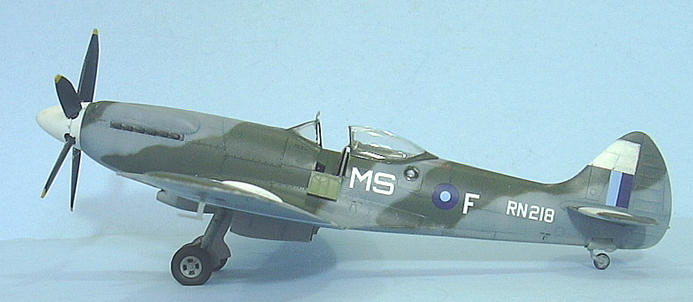
Development of the Spitfire to use the more powerful Rolls-Royce Griffon
engine began in late 1940, with what was first known as the Spitfire IV, which
was to use the Griffon II and was known as the Type 337.
The airframe involved extensive modification to absorb the additional
power; at one time it flew with a mockup of no less than three 20mm cannon in
each wing. Before the prototype
DP845 flew, 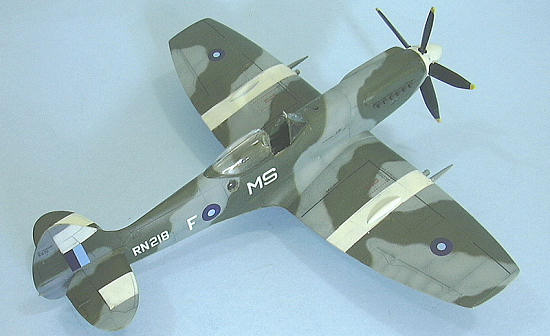 it was designated the Spitfire XX to distinguish it from the P.R.
Mk. IV. Plans that all XX-series
Spitfires would be Griffon-powered were changed when the interim Mk. XII and Mk.
XIV types were introduced.
it was designated the Spitfire XX to distinguish it from the P.R.
Mk. IV. Plans that all XX-series
Spitfires would be Griffon-powered were changed when the interim Mk. XII and Mk.
XIV types were introduced.
The Mk. XII was an emergency creation to deal with the low-level “tip-and
run” raids by Fw-190s and involved mating the Griffon II engine to a Mk. Vc
airframe. The more detailed development utilized DP851, which was used to
develop the Griffon 61 series.
DP851 was further developed into the Spitfire XXI.
In order to gain further experience with the Griffon-61, six Mk. VIII
airframes, JF316 to JF321 were modified to take the Griffon engine.
Experience with these airplanes showed it would be possible to create a
Griffon-powered high-altitude air superiority fighter in a faster timeframe than
envisioned with the Spitfire XXI by mating the Griffon to the Mk. VIII airframe
the way the Merlin-61 had been mated to the Spitfire Vc.
Thus, third major development of the Spitfire saw the “interim” type
produced in larger numbers and used more widely than the version developed
specifically to use the engine change.
While the Spitfire XIV saw most of its operational service in the ETO,
the type was sent to
Southeast Asia
with aircraft arriving in
India
in the spring of 1945, with both the “standard” Spitfire XIVe and the
fighter-reconnaissance F.R.XIVe with its cut down fuselage and “bubble” canopy
represented. With the squadrons
equipped with the Spitfire VIII on operations during the final British offensive
in
Burma,
it was difficult to withdraw them for conversion on to the Spitfire XIV and give
them enough time to gain experience before returning to operations.
Thus, none of the Spitfire XIV-equipped squadrons saw combat before the
end of the war, though several squadrons were ready for operations had the
British offensive con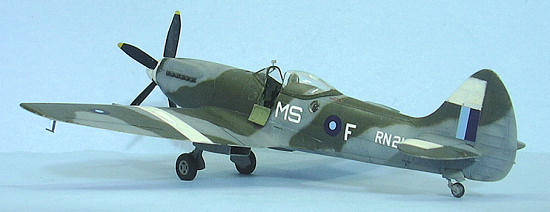 tinued past September.
As it was, these squadrons were based at Singapore and Hong Kong in the
immediate post-war period, and were also sent on to take part in the occupation
of Japan, where they served until 1948.
tinued past September.
As it was, these squadrons were based at Singapore and Hong Kong in the
immediate post-war period, and were also sent on to take part in the occupation
of Japan, where they served until 1948.
RAF Spitfire XIVs were sold to India where they equipped several
squadrons of the Indian Air Force, and were used until the early 1950s, during
which time they participated in the first Indo-Pakistani War following
independence in 1948-49.
One F.R.XIVe was sent to
Canada
for winterization tests in 1946. It
was bought surplus and was to have been entered in the 1949 Thompson Trophy
Race, but failed to qualify. This
airplane spent many years in a private collection in
Colorado
where it wasn’t flown, though it has now been sold and restored to flight status
in the
United States.
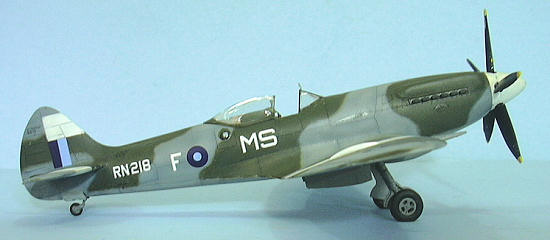 The Academy Spitfire F.R.XIVe kit first appeared in 1994, along with the
Spitfire XIV kit. Unfortunately,
these kits are inaccurate in a way that is not easily corrected.
The fuselage is too deep, which makes the nose much larger than it
actually should be, in both height and width.
This is unfortunate because the kit is very “buildable,” with
crisply-molded parts and good fit.
The dimensional mistakes are not terribly obvious unless one sits the completed
model next to an accurate Spitfire XIV, or the Airfix Spitfire 22/24, at which
point it takes on a “bulldog” look that is very un-Spitfire-like.
The Academy Spitfire F.R.XIVe kit first appeared in 1994, along with the
Spitfire XIV kit. Unfortunately,
these kits are inaccurate in a way that is not easily corrected.
The fuselage is too deep, which makes the nose much larger than it
actually should be, in both height and width.
This is unfortunate because the kit is very “buildable,” with
crisply-molded parts and good fit.
The dimensional mistakes are not terribly obvious unless one sits the completed
model next to an accurate Spitfire XIV, or the Airfix Spitfire 22/24, at which
point it takes on a “bulldog” look that is very un-Spitfire-like.
This particular release of the kit is a special limited run edition with
decals for Belgian, Indian, and RAF Spitfire F.R.XIVe aircraft, including
markings for a Spitfire in
SEAC
markings, which is what I chose to use.
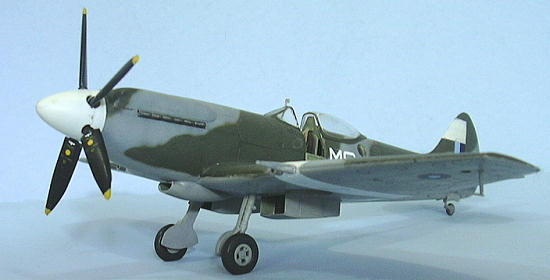 I wanted to try and reduce the oversize nose, so I filled in the lower
cowling area with cyanoacrylate glue, then taped the fuselage halves together
and sanded that down as much as I could ti give it a finer profile.
I wanted to try and reduce the oversize nose, so I filled in the lower
cowling area with cyanoacrylate glue, then taped the fuselage halves together
and sanded that down as much as I could ti give it a finer profile.
I also used cockpit parts from other Spitfire kits, primarily the Airfix
Spitfire 22 parts from the Eduard release that includes a resin replacement
cockpit. I also used an Eduard
photoetch instrument panel and seatbelts.
The end result is a bit more “busy” than what you obtain from the kit
cockpit without modification.
Final assembly of the model once the fuselage was together was simple and
presented no problems.
Painting:
I pre-shaded the model with flat black on the panel lines, then applied
white paint for the
SEAC
ID stripes, which I then masked off.
The model was then painted the standard European temperate scheme of
O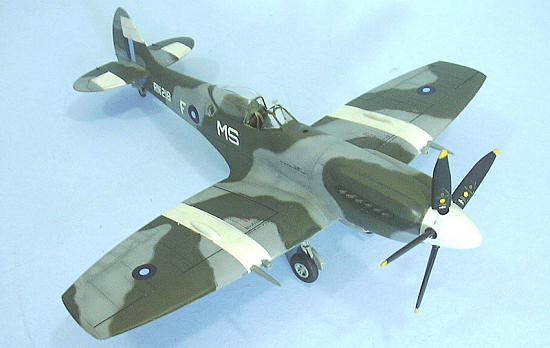 cean Grey and Dark Green upper surfaces and Sea Grey Medium lower surfaces.
There has long been conjecture that these Spitfires were repainted on
arrival in the
SEAC
Tropical Land Scheme of Dark Earth and Dark Green over Sea Grey Medium, but the
fact that the RAF was “under the gun” to re-equip with these fighters and get
them into operations as quickly as possible militates against this.
Since all the photos of
SEAC
Spitfire XIVs are black-and-white, this will likely never be an argument that
will be finally resolved, but the weight of evidence is against the repaint.
cean Grey and Dark Green upper surfaces and Sea Grey Medium lower surfaces.
There has long been conjecture that these Spitfires were repainted on
arrival in the
SEAC
Tropical Land Scheme of Dark Earth and Dark Green over Sea Grey Medium, but the
fact that the RAF was “under the gun” to re-equip with these fighters and get
them into operations as quickly as possible militates against this.
Since all the photos of
SEAC
Spitfire XIVs are black-and-white, this will likely never be an argument that
will be finally resolved, but the weight of evidence is against the repaint.
Decals:
The kit decals were used throughout and presented no difficulties.
When they were set, I washed the model to get rid of solvent residue,
then gave the model several coats of Xtracrylix Flat Varnish that was
additionally “flattened” by the addition of Tamiya Flat Base to get the kind of
finish one sees on aircraft after they have been under the tropic sun for a few
months.
I had re-shaped the propeller blades, thinning them down at the same
time, to make them more accurate in their final look.
I fitted these to the spinner, then attached the landing gear, unmasked
the windscreen and canopy, and attached the canopy in the open position.
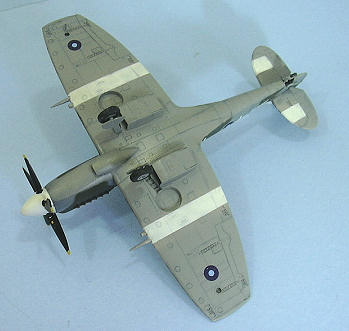 Unless one is willing pull out the razor saw and do a “kitbash” using the
Airfix Spitfire 22/24 (fuselage), the Hasegawa Spitfire IX (wings, cockpit and
horizontal stabilizer), and the Academy kit (radiators and vertical fin and
rudder) for the various bits to create a Spitfire XIV with an accurate shape,
this kit by Academy is as close as you will get to a Spitfire XIV in 1/48 for
now - and likely for time to come.
Its faults are known and if you can live with them, the result is a nice model
that won’t take forever to finish.
I do recommend this
release specifically due to its wide range of markings possibilities.
Unless one is willing pull out the razor saw and do a “kitbash” using the
Airfix Spitfire 22/24 (fuselage), the Hasegawa Spitfire IX (wings, cockpit and
horizontal stabilizer), and the Academy kit (radiators and vertical fin and
rudder) for the various bits to create a Spitfire XIV with an accurate shape,
this kit by Academy is as close as you will get to a Spitfire XIV in 1/48 for
now - and likely for time to come.
Its faults are known and if you can live with them, the result is a nice model
that won’t take forever to finish.
I do recommend this
release specifically due to its wide range of markings possibilities.
Review kit
courtesy of my wallet.
Tom Cleaver
July 2009
Copyright ModelingMadness.com
If you would like your product reviewed fairly and fairly quickly, please
contact
the editor or see other details in the
Note to
Contributors.
Back to the Main Page
Back to the Review
Index Page 2017


 it was designated the Spitfire XX to distinguish it from the P.R.
Mk. IV. Plans that all XX-series
Spitfires would be Griffon-powered were changed when the interim Mk. XII and Mk.
XIV types were introduced.
it was designated the Spitfire XX to distinguish it from the P.R.
Mk. IV. Plans that all XX-series
Spitfires would be Griffon-powered were changed when the interim Mk. XII and Mk.
XIV types were introduced. tinued past September.
As it was, these squadrons were based at Singapore and Hong Kong in the
immediate post-war period, and were also sent on to take part in the occupation
of Japan, where they served until 1948.
tinued past September.
As it was, these squadrons were based at Singapore and Hong Kong in the
immediate post-war period, and were also sent on to take part in the occupation
of Japan, where they served until 1948. The Academy Spitfire F.R.XIVe kit first appeared in 1994, along with the
Spitfire XIV kit. Unfortunately,
these kits are inaccurate in a way that is not easily corrected.
The fuselage is too deep, which makes the nose much larger than it
actually should be, in both height and width.
This is unfortunate because the kit is very “buildable,” with
crisply-molded parts and good fit.
The dimensional mistakes are not terribly obvious unless one sits the completed
model next to an accurate Spitfire XIV, or the Airfix Spitfire 22/24, at which
point it takes on a “bulldog” look that is very un-Spitfire-like.
The Academy Spitfire F.R.XIVe kit first appeared in 1994, along with the
Spitfire XIV kit. Unfortunately,
these kits are inaccurate in a way that is not easily corrected.
The fuselage is too deep, which makes the nose much larger than it
actually should be, in both height and width.
This is unfortunate because the kit is very “buildable,” with
crisply-molded parts and good fit.
The dimensional mistakes are not terribly obvious unless one sits the completed
model next to an accurate Spitfire XIV, or the Airfix Spitfire 22/24, at which
point it takes on a “bulldog” look that is very un-Spitfire-like.

